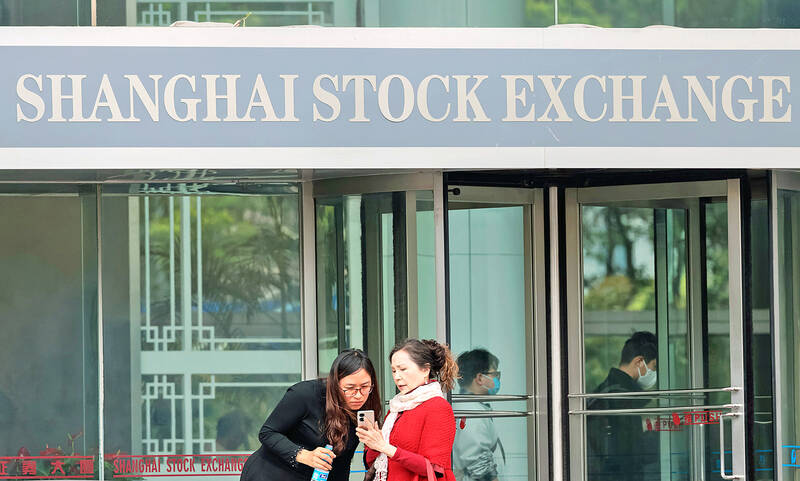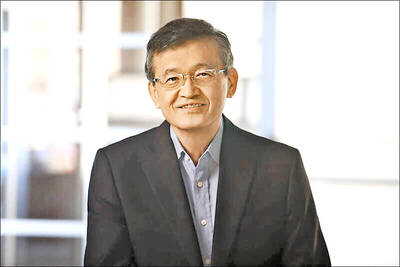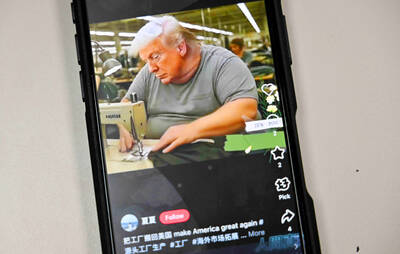Emerging-market bulls betting that China’s reopening would drive a year of asset outperformances are seeing their dreams turn into dust.
The benchmark gauge for developing-nation stocks has not only totted up losses of more than 7 percent since a peak in January, but is also underperforming its rich-nation counterpart by the most in three years. Chinese shares have contributed 70 percent of those losses, helping to erase US$750 billion in market value.
The sell-off is spreading to nations with the closest trade ties to China, such as South Korea and South Africa.

Photo: EPA-EFE
The losses have come despite the second-biggest economy expanding at a faster-than-forecast clip, led by surging exports and consumer demand. That underscores a plethora of idiosyncratic risks, not the least of which are China’s increasingly assertive stance on Taiwan, its relationship with Russia and the regulation of the private sector.
Investors remain underexposed to China as they seek more consistent policy signals that can sustain the economic recovery.
“Even though data is still supportive of China recovery, we of course are still a bit more skeptical and look through to see if that recovery is that real,” Wilfred Wee (黃志忠), a money manager at Ninety One Singapore Pte Ltd (晉達資產管理), said on Bloomberg Television. “It’s not just about a sweetener or a reserve-requirement-ratio cut, it’s about coaxing and engaging companies to excite the private sector.”
The MSCI Emerging Markets Index was heading for a 1.5 percent decline last month, trimming this year’s advance to 2 percent, while the MSCI World Index of developed-market equities was sitting on gains of four times as much. That has sent the ratio between emerging markets and rich nations down 5.6 percent this year, the biggest retreat since at least 2020.
China’s economic data have indeed shown improvement. First-quarter GDP rose by 4.5 percent from a year earlier, beating estimates of 4 percent, while retail sales in March accelerated at their fastest rate since June 2021.
Peering beneath the hood, investors question whether the strong growth figures would continue into the second half of the year, after data over the weekend suggested the recovery remains lopsided, with the production side of the economy lagging the rebound in consumption.
Meanwhile, Beijing is opening up new battle lines in its geopolitical quest. Escalating tensions with Washington on issues from Taiwan to TikTok and semiconductor chips threaten to make China a no-go for western capitalists.
US President Joe Biden is in the midst of corralling support from other nations in its efforts to curb investment into China’s high-tech industries, and plans to take action around the time of the G7 summit next month.
“The hurdle is very high,” Union Bancaire Privee SA managing director Ling Vey-sern (凌煒森) said. “China has numerous perceived risks which puts it on a low priority for non-benchmarked investors. So unless the investment case is very clear or risk-reward is extremely attractive, it may be difficult to convince investors to put more cash to work in China.”
Asset allocators are voting with their feet. Overseas funds sold a net US$660 million worth of onshore China stocks last month, the first net foreign monthly outflow this year.
The MSCI China Index tumbled 5.3 percent last month, erasing this year’s advance. The gauge was poised to end last month with a 19 percent valuation discount relative to the rest of emerging markets, a far cry from the 15 percent premium it traded at a year ago.
Currencies are similarly feeling the spillovers from China’s uncertain growth outlook. Asian currencies have underperformed against the US dollar so far this year, as the region’s export-driven economies are dependent on China’s outlook, while Latin America’s currencies gained against the greenback mainly due to the higher carry-on offer.
History shows “it takes two quarters to convince investors that the recovery is real,” Macquarie Group Ltd’s head of China economics Larry Hu (胡偉俊) wrote last month. “Despite the stronger-than-expected first quarter GDP number, the debate on recovery will continue in the second quarter.”

Intel Corp chief executive officer Lip-Bu Tan (陳立武) is expected to meet with Taiwanese suppliers next month in conjunction with the opening of the Computex Taipei trade show, supply chain sources said on Monday. The visit, the first for Tan to Taiwan since assuming his new post last month, would be aimed at enhancing Intel’s ties with suppliers in Taiwan as he attempts to help turn around the struggling US chipmaker, the sources said. Tan is to hold a banquet to celebrate Intel’s 40-year presence in Taiwan before Computex opens on May 20 and invite dozens of Taiwanese suppliers to exchange views

Application-specific integrated circuit designer Faraday Technology Corp (智原) yesterday said that although revenue this quarter would decline 30 percent from last quarter, it retained its full-year forecast of revenue growth of 100 percent. The company attributed the quarterly drop to a slowdown in customers’ production of chips using Faraday’s advanced packaging technology. The company is still confident about its revenue growth this year, given its strong “design-win” — or the projects it won to help customers design their chips, Faraday president Steve Wang (王國雍) told an online earnings conference. “The design-win this year is better than we expected. We believe we will win

Chizuko Kimura has become the first female sushi chef in the world to win a Michelin star, fulfilling a promise she made to her dying husband to continue his legacy. The 54-year-old Japanese chef regained the Michelin star her late husband, Shunei Kimura, won three years ago for their Sushi Shunei restaurant in Paris. For Shunei Kimura, the star was a dream come true. However, the joy was short-lived. He died from cancer just three months later in June 2022. He was 65. The following year, the restaurant in the heart of Montmartre lost its star rating. Chizuko Kimura insisted that the new star is still down

While China’s leaders use their economic and political might to fight US President Donald Trump’s trade war “to the end,” its army of social media soldiers are embarking on a more humorous campaign online. Trump’s tariff blitz has seen Washington and Beijing impose eye-watering duties on imports from the other, fanning a standoff between the economic superpowers that has sparked global recession fears and sent markets into a tailspin. Trump says his policy is a response to years of being “ripped off” by other countries and aims to bring manufacturing to the US, forcing companies to employ US workers. However, China’s online warriors